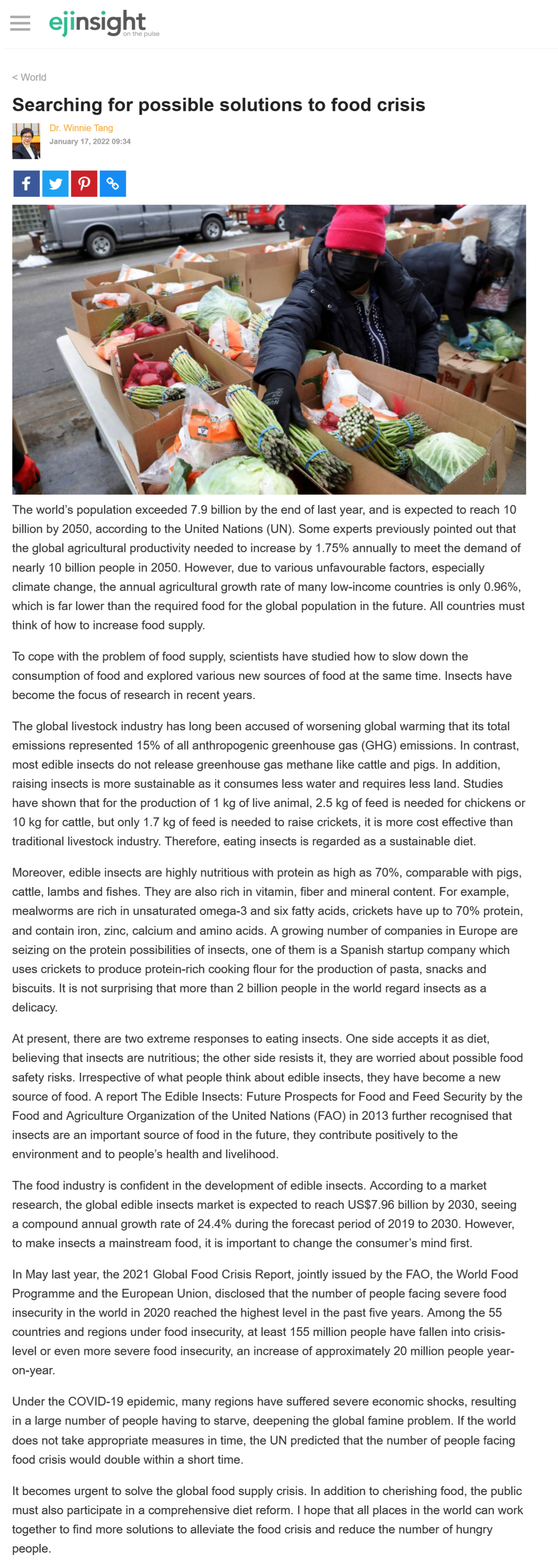網上版請按此

Searching for possible solutions to food crisis
The world's population exceeded 7.9 billion by the end of last year, and is expected to reach 10 billion by 2050, according to the United Nations (UN). Some experts previously pointed out that the global agricultural productivity needed to increase by 1.75% annually to meet the demand of nearly 10 billion people in 2050. However, due to various unfavourable factors, especially climate change, the annual agricultural growth rate of many low-income countries is only 0.96%, which is far lower than the required food for the global population in the future. All countries must think of how to increase food supply.
To cope with the problem of food supply, scientists have studied how to slow down the consumption of food and explored various new sources of food at the same time. Insects have become the focus of research in recent years.
The global livestock industry has long been accused of worsening global warming that its total emissions represented 15% of all anthropogenic greenhouse gas (GHG) emissions. In contrast, most edible insects do not release greenhouse gas methane like cattle and pigs. In addition, raising insects is more sustainable as it consumes less water and requires less land. Studies have shown that for the production of 1 kg of live animal, 2.5 kg of feed is needed for chickens or 10 kg for cattle, but only 1.7 kg of feed is needed to raise crickets, it is more cost effective than traditional livestock industry. Therefore, eating insects is regarded as a sustainable diet.
Moreover, edible insects are highly nutritious with protein as high as 70%, comparable with pigs, cattle, lambs and fishes. They are also rich in vitamin, fiber and mineral content. For example, mealworms are rich in unsaturated omega-3 and six fatty acids, crickets have up to 70% protein, and contain iron, zinc, calcium and amino acids. A growing number of companies in Europe are seizing on the protein possibilities of insects, one of them is a Spanish startup company which uses crickets to produce protein-rich cooking flour for the production of pasta, snacks and biscuits. It is not surprising that more than 2 billion people in the world regard insects as a delicacy.
At present, there are two extreme responses to eating insects. One side accepts it as diet, believing that insects are nutritious; the other side resists it, they are worried about possible food safety risks. Irrespective of what people think about edible insects, they have become a new source of food. A report The Edible Insects: Future Prospects for Food and Feed Security by the Food and Agriculture Organization of the United Nations (FAO) in 2013 further recognised that insects are an important source of food in the future, they contribute positively to the environment and to people's health and livelihood.
The food industry is confident in the development of edible insects. According to a market research, the global edible insects market is expected to reach US$7.96 billion by 2030, seeing a compound annual growth rate of 24.4% during the forecast period of 2019 to 2030. However, to make insects a mainstream food, it is important to change the consumer's mind first.
In May last year, the 2021 Global Food Crisis Report, jointly issued by the FAO, the World Food Programme and the European Union, disclosed that the number of people facing severe food insecurity in the world in 2020 reached the highest level in the past five years. Among the 55 countries and regions under food insecurity, at least 155 million people have fallen into crisis-level or even more severe food insecurity, an increase of approximately 20 million people year-on-year.
Under the COVID-19 epidemic, many regions have suffered severe economic shocks, resulting in a large number of people having to starve, deepening the global famine problem. If the world does not take appropriate measures in time, the UN predicted that the number of people facing food crisis would double within a short time.
It becomes urgent to solve the global food supply crisis. In addition to cherishing food, the public must also participate in a comprehensive diet reform. I hope that all places in the world can work together to find more solutions to alleviate the food crisis and reduce the number of hungry people.
Dr. Winnie Tang
Adjunct Professor, Department of Computer Science, Faculty of Engineering; Department of Geography, Faculty of Social Sciences; and Faculty of Architecture, The University of Hong Kong